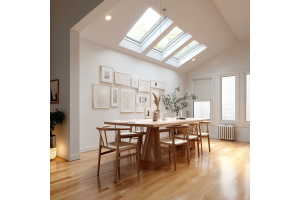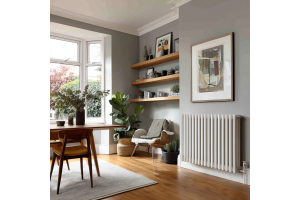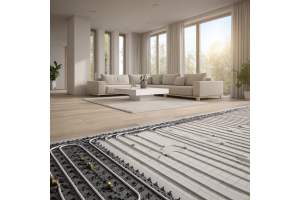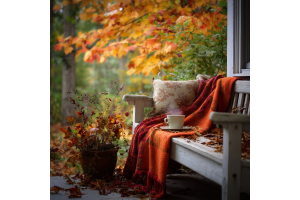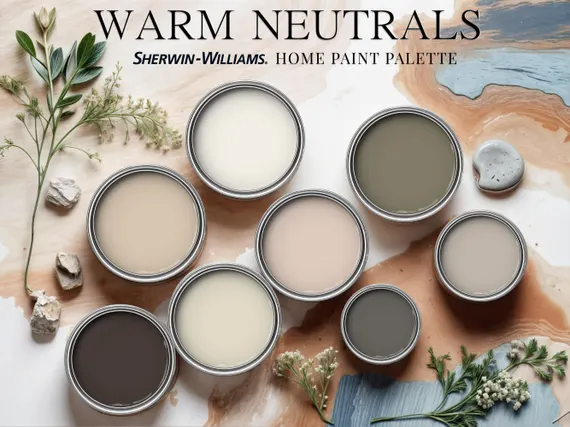
Why Warm Colours Feel Warmer
Colour is more than just a design choice—it’s a powerful sensory tool that influences how we experience our surroundings. When we describe certain colours as “warm,” it’s not just a metaphor. Our brains and bodies genuinely react to colour in ways that can alter our perception of temperature and comfort. Understanding this connection helps explain why painting a room in earthy reds, golden yellows, or soft terracottas can make it feel cozier—even if the thermostat remains unchanged.
1. The Hue–Heat Hypothesis
Psychologists have long studied the link between colour and perceived warmth, known as the hue–heat hypothesis. This theory suggests that warm colours—reds, oranges, and yellows—are consistently associated with warmth, while cool colours—blues, greens, and violets—are linked with coolness. In experiments, people often estimate the same room to be several degrees warmer when painted in warm tones compared to cool ones. This doesn’t raise the actual temperature, but it creates a psychological warmth that encourages relaxation and comfort.
2. Emotional Associations
Warm colours tap into powerful emotional connections:
-
Red brings to mind fire, candlelight, and passion.
-
Orange evokes autumn leaves, sunsets, and glowing embers.
-
Yellow reminds us of sunshine and warmth on the skin.
These associations trigger feelings of coziness, safety, and togetherness, which are especially valuable in the darker, colder months. By contrast, cool shades often remind us of ice, water, and open air—refreshing but not necessarily comforting in winter.
3. Light Reflection and Atmosphere
The undertone and finish of a colour also influence how “warm” it feels:
-
Warm pigments reflect light with a golden or reddish tint, giving rooms a gentle glow that mimics natural sunlight.
-
Cool colours reflect light in a bluish way, which can make spaces feel sharper or even chilly.
-
Finishes like matte or eggshell absorb more light, adding to the cocooning effect, while glossy finishes bounce cooler reflections around the room.
This is why a cream with yellow undertones feels warmer than a stark pure white, and why soft taupe can feel more inviting than a cool gray.
4. Physical Responses
Interestingly, colour can influence physiological reactions. Studies show that exposure to warm colours can slightly increase heart rate and even skin temperature, while cooler colours can slow heart rate and create a sensation of coolness. Although subtle, these effects reinforce the feeling of warmth and snugness in a room painted with warm hues.
5. Context and Cultural Cues
Perception is also shaped by culture and context. Across many societies, warm shades are linked with energy, food, and community—think of terracotta homes in Mediterranean regions or the warm, rich interiors of traditional cottages. These cultural associations strengthen the link between warm colours and the idea of comfort and homeliness.
6. The Power of Contrast
Warm colours also feel warmer when contrasted with cooler shades. For instance, a burnt orange feature wall will seem especially cozy if paired with cooler gray flooring or blue-toned textiles. The juxtaposition enhances the psychological warmth of the colour, drawing attention and creating a cocooning effect.
✅ In short: Warm colours feel warmer because they:
-
Psychologically link to fire, sunlight, and earth.
-
Reflect light with golden undertones.
-
Subtly affect our body’s physiological responses.
-
Connect to cultural ideas of comfort and hospitality.
-
Gain intensity when contrasted with cooler shades.
By harnessing these factors, you can make a room feel more welcoming and snug—without touching the thermostat.
Top Colour Categories to Create Warmth
Not all warm colours are created equal. Some bring rich, dramatic warmth ideal for evening lounges, while others deliver a gentle glow perfect for all-day comfort. To help you choose the right shade for your space, here are the main categories of warm wall colours—along with tips on where and how to use them.
1. Earthy and Rich Accent Colours
These shades bring depth, intimacy, and character. They are bold choices that make a statement, ideal for feature walls, alcoves, or entire rooms if you love a cocooning effect.
-
Deep Terracotta
-
Why it works: Inspired by sun-baked clay, terracotta instantly adds rustic warmth and grounding energy.
-
Best for: Dining rooms, hallways, or feature walls in living spaces.
-
Pairs well with: Natural wood, rattan, cream textiles, and brass accents.
-
-
Mustard Yellow
-
Why it works: Brighter than earth tones but still cozy, mustard feels cheerful without being overpowering.
-
Best for: Kitchens, home offices, or hallways where energy is welcome.
-
Pairs well with: Warm whites, olive greens, matte black details.
-
-
Rich Burgundy or Wine Red
-
Why it works: Creates a luxurious, enveloping feel with a sense of drama.
-
Best for: Dining rooms, bedrooms, or reading nooks.
-
Pairs well with: Candlelight, gold-framed mirrors, and plush fabrics like velvet.
-
-
Burnt Orange
-
Why it works: Energising yet cozy, orange adds vibrancy without the harshness of primary red.
-
Best for: Accent walls, fireplaces, or cosy corners.
-
Pairs well with: Neutral beiges, dark wood, and leafy plants.
-
2. Warm Neutrals and Soft Tones
If bold isn’t your style, warm neutrals are the most versatile category, bringing subtle coziness without overwhelming the space. They work in modern interiors, open-plan rooms, or anywhere you want a calming backdrop.
-
Creams with Yellow or Beige Undertones
-
Why it works: Softer than stark white, these shades create a sunlit glow.
-
Best for: North-facing rooms or spaces lacking natural light.
-
Pairs well with: Warm oak floors, soft linens, or pale stone radiators.
-
-
Warm Taupe or Greige (Gray-Beige)
-
Why it works: Offers modern sophistication with a gentle warmth, adapting beautifully to changing light.
-
Best for: Living rooms, bedrooms, or minimalist interiors.
-
Pairs well with: Black accents, bronze fixtures, and textured textiles.
-
-
Soft Beige or Honeyed Sand
-
Why it works: Evokes natural earth and beach tones, creating calm coziness.
-
Best for: Family rooms, bathrooms, or layered open-plan spaces.
-
Pairs well with: Warm metallics, terracotta accessories, natural fibres.
-
3. Muted Greens, Browns, and Earthy Naturals
Nature-inspired shades add grounding comfort while remaining timeless. They’re perfect for spaces where you want warmth without overly bold colour.
-
Olive Green
-
Why it works: Deep and grounding, olive feels organic and sophisticated.
-
Best for: Kitchens, studies, or living rooms.
-
Pairs well with: Wooden furniture, brass hardware, linen textiles.
-
-
Sage Green with Warm Undertones
-
Why it works: Lighter than olive but still earthy, sage brings calm while maintaining warmth.
-
Best for: Bedrooms and bathrooms.
-
Pairs well with: Cream whites, terracotta pots, natural stone.
-
-
Warm Chocolate or Coffee Brown
-
Why it works: Dark yet cozy, brown is making a comeback as a comforting alternative to gray.
-
Best for: Snug lounges, dens, or media rooms.
-
Pairs well with: Cream textiles, golden light fittings, and leather accents.
-
-
Urbane Bronze (Brown-Gray)
-
Why it works: A sophisticated neutral that feels enveloping and stylish.
-
Best for: Feature walls or accent areas.
-
Pairs well with: Crisp whites, natural greenery, textured throws.
-
4. Warm Pinks and Subtle Reds
Not all pinks are sugary sweet—when chosen carefully, muted or earthy pinks add soft, flattering warmth to interiors.
-
Setting Plaster (Dusty Pink)
-
Why it works: A gentle, historic pink that looks both cozy and elegant.
-
Best for: Bedrooms, nurseries, or relaxing lounges.
-
Pairs well with: Aged brass, vintage woods, and muted greens.
-
-
Cinnamon or Spiced Coral
-
Why it works: Combines the energy of red with the warmth of orange, creating a lively yet snug feel.
-
Best for: Dining rooms, kitchens, or lively family spaces.
-
Pairs well with: Warm neutrals, dark metals, rustic décor.
-
-
Blush Beige
-
Why it works: A neutral with a pink undertone, offering softness without overwhelming the room.
-
Best for: Bathrooms, entryways, or minimalist interiors.
-
Pairs well with: Marble, brass, and natural light.
-
5. Golden and Ochre Tones
These are among the most sun-like shades, bringing instant brightness and warmth. They work brilliantly in spaces where natural light is limited.
-
Ochre or Indian Yellow
-
Why it works: A deep, glowing yellow that feels rich and enveloping.
-
Best for: Dining rooms, kitchens, or heritage-style interiors.
-
Pairs well with: Dark woods, black accents, patterned tiles.
-
-
Golden Beige or Wheat
-
Why it works: A more muted version of ochre, ideal for creating warmth without overwhelming brightness.
-
Best for: Living rooms, bedrooms, or traditional homes.
-
Pairs well with: Warm whites, rustic wood, and woven textures.
-
✅ Tip for Readers:
Think of wall colour like layering clothing. Bold shades are like a winter coat—immediately noticeable and dramatic—while warm neutrals are like a cozy jumper, versatile and adaptable. By mixing the two, you can strike the perfect balance between atmosphere and practicality.
Practical Tips for Application
Choosing the right warm wall colour is only half the battle. The way you apply it, where you place it, and how you style it can make the difference between a room that feels inviting and one that feels overwhelming. Below are practical, design-tested tips to help you get the best results.
1. Consider Room Orientation and Natural Light
-
North-facing rooms tend to have cooler, bluish daylight, which can make colours appear colder. In these spaces, lean into rich terracottas, golden yellows, or warm taupes to balance the cool light.
-
South-facing rooms are naturally warmer and brighter. Here, you can afford softer warm neutrals (cream, warm beige, blush pink) without the risk of the space feeling chilly.
-
East-facing rooms get cool morning light but warmer afternoon glow—use mid-tone warm shades (peach, dusty pink) that shift beautifully with changing light.
-
West-facing rooms are cooler during the morning but bathed in golden light later—accentuate this with ochres, cinnamon, or earthy neutrals.
Tip: Always test paint samples on different walls of the same room and observe them at various times of day before committing.
2. Use Bold Warm Tones as Accents
Deep reds, burgundies, or burnt oranges can feel too heavy across all four walls. Instead, apply them strategically:
-
A feature wall behind the bed or sofa.
-
Painted door frames, alcoves, or fireplace surrounds.
-
Half-height painting (with warm colour on the bottom, soft neutral on top) for a cozy but balanced effect.
This allows you to introduce richness without overpowering the space.
3. Layer with Textures and Materials
Colour alone can’t do all the heavy lifting—pairing warm shades with complementary materials amplifies the coziness:
-
Wood: Oak, walnut, and reclaimed timber deepen warmth.
-
Fabrics: Wool throws, linen curtains, and velvet cushions add tactile comfort.
-
Metals: Brass, copper, or bronze fixtures highlight warm undertones.
-
Stone and ceramics: Terracotta tiles or pottery echo earthy palettes.
This layered approach ensures the room feels inviting both visually and physically.
4. Choose the Right Paint Finish
The finish of your paint affects how the colour is perceived:
-
Matte or eggshell absorbs more light, making spaces feel intimate and soft.
-
Satin or silk reflects a gentle glow—ideal for hallways or kitchens where some light bounce is useful.
-
Gloss is rarely used for full walls but can add a warm accent on trims and doors.
For warmth, matte and eggshell are usually the most effective.
5. Combine Warm and Neutral Shades
A room drenched entirely in dark warm colours can sometimes feel heavy. Balance is key:
-
Pair deep tones (burgundy, terracotta) with light warm neutrals (cream, alabaster, warm white) to stop the space from closing in.
-
In open-plan spaces, use warm neutrals as a base and reserve bold shades for zoning (e.g., painting the dining area in a richer tone).
-
Add pops of warm accent colours (cushions, rugs, lampshades) to reinforce the theme.
6. Use Lighting to Enhance Warmth
Artificial lighting can make or break your chosen palette.
-
Warm white bulbs (2700–3000K) intensify the effect of warm paint shades.
-
Layered lighting—ambient (ceiling), task (reading lamps), and accent (wall lights)—creates pockets of warmth and coziness.
-
Avoid cool white LED bulbs, which can clash with warm walls and make them appear dull.
Tip: A golden glow from lamps against a warm wall colour magnifies the cozy effect dramatically.
7. Small Spaces vs. Large Spaces
-
In small rooms, rich warm colours create a cocoon-like intimacy—ideal for reading corners, snug lounges, or powder rooms.
-
In large rooms or open-plan layouts, stick to warmer neutrals on the majority of walls, then use deeper colours in smaller zones to create coziness without shrinking the whole space.
8. Don’t Forget the Fifth Wall (Ceilings)
Most homeowners default to plain white ceilings, but this can sometimes clash with warm wall colours.
-
Try a slightly warmer off-white or a pale tone that complements your wall shade.
-
For maximum coziness, paint the ceiling the same colour as the walls—this creates a cocooning effect perfect for bedrooms or snug lounges.
9. Test Before You Commit
Paint colours always look different in reality than on a swatch.
-
Apply generous patches (at least 1m²) on multiple walls.
-
Look at them in morning, afternoon, and evening light.
-
Consider how the colour interacts with flooring, radiators, and furniture.
This extra step saves disappointment and ensures the warmth you want is actually achieved.
✅ Summary Tip: Think of warm wall colours as part of a whole design recipe: orientation + paint finish + lighting + materials. Get these elements working together, and your room will not only look but feel warmer all year round.
Conclusion: Warmth Without Touching the Thermostat
Creating a home that feels warm and inviting doesn’t always mean turning up the heating system. As we’ve seen, the colours on your walls have a powerful impact on how a space is experienced—both emotionally and physically. Warm tones like terracotta, mustard yellow, cinnamon pinks, and golden neutrals tap into our natural associations with fire, sunlight, and earth, making rooms feel several degrees cozier without a single change in temperature.
The key lies in choosing the right palette for your space: bold earthy accents for drama, soft neutrals for versatility, or muted greens and browns for grounding calm. By layering these shades with the right lighting, textures, and finishes, you can transform any room into a sanctuary of comfort—even in the middle of winter.
This approach isn’t just about aesthetics; it’s about energy efficiency and mindful living. If your walls make you feel warmer, you’ll be less tempted to nudge the thermostat upwards, helping you save on energy bills and reduce your carbon footprint at the same time.
And remember, colour works beautifully when paired with the right heating solutions. At Geyser, our designer radiators and towel rails come in a wide range of finishes—many of which complement these warm palettes perfectly. From sleek anthracite and brushed brass to soft creams and timeless whites, your heating can become a seamless part of your design scheme while keeping your home cozy in both look and feel.
So, whether you’re refreshing a single wall or reimagining your entire interior, think of colour as your secret tool for comfort. With the right shades, you can create a home that feels warm, welcoming, and stylish—all without raising the thermostat.



